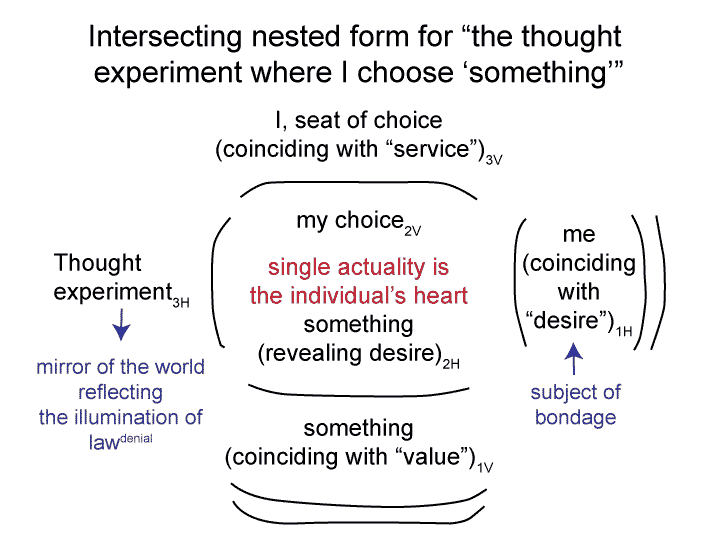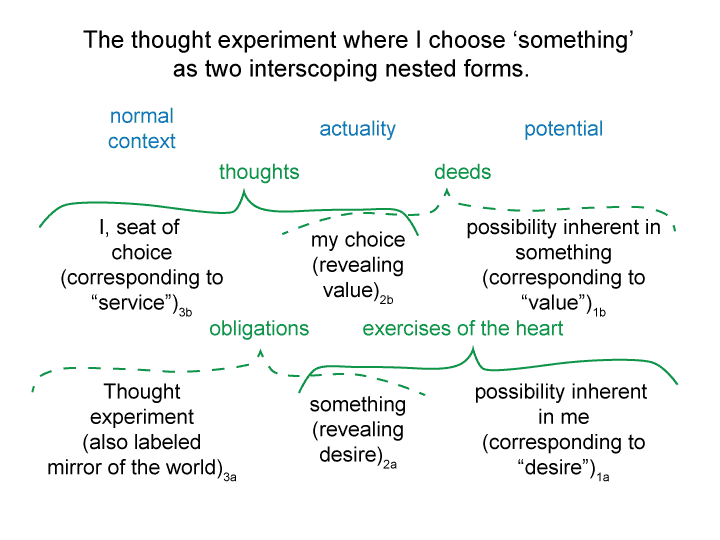Man and Sin by Piet Schoonenberg (1964) 2.3 MT
[… that obligations3H(2 for the intersecting nested forms, corresponds to:
Mirror of the world3H(my heart2
In the intersection, my heart2 is the single actuality of my choice2V and ‘something’ contextualized by the mirror of the world2H.
Words3H(2H, excuses3H(2H and resentments3H(2H correspond to the latter actuality.
They still cry out, “I am not responsible.”
But how irresponsible is that?
In my heart, I know that the values that I have been choosing1V no longer represent the desires inherent in me1H.
In our heart, I know the truth that I cannot accept:
My resentments are co-opposed to bondage.]
Man and Sin by Piet Schoonenberg (1964) 2.3 MS
[The person believes that this cry, this something2a, is valid.
The person simply presumes that their mirror of the world3a reflects their values1b.
Sensible construction allows this.
Sensible construction cannot question the social construction that it presumes.
Sensible construction must give way to an intersection.
Otherwise, one cannot step back, detach and see …]
Man and Sin by Piet Schoonenberg (1964) 2.3 MR
[Does this sound vaguely familiar?
Consider the interscope.
Obligations3a(2a (responsibilities3a(2a or words3a(2a) correspond to:
Mirror of the world3a(something2a
Words3a(2a, excuses3a(2a and resentments3a(2a all cry out, ‘I am not responsible.’
This cry is co-opposed to bondage. Yet the person does not know it.]
Man and Sin by Piet Schoonenberg (1964) 2.3 MQ
[How is the mirror of the world3H to blame?
It is filled with blame.
Blame within the mirror of the world3H offers an alternate to responsibility and freedom.
Blame within the mirror of the world3H offers words and bondage.
There is an element of truth to the blame game.
This may be why Schoonenberg hopes to conceive of Original Sin as the sinfulness of social structures.]
Man and Sin by Piet Schoonenberg (1964) 2.3 MP
Summary of text [comment] page 83
Schoonenberg wrote that we exercise freedom in serving either God or Satan.
[The previous figure complements Schoonenberg’s view.
How?
Well, it provides an excuse.
IF the thought experiment3H regulates the following:
I, seat of choice3V( my choice and something2 ( potentials of something of value1V))
AND IF I, seat of choice3V does not serve God,
THEN the mirror of the world3H is to blame.]
Man and Sin by Piet Schoonenberg (1964) 2.3 MN
[In the corresponding intersection, the potential of me1H is situated by my heart2 through the normal context of the thought experiment3H or mirror of the world3H.
In this configuration, one can imagine how the vertical nested form may be regulated by the horizontal.
By contextualizing (permitting, inspiring, regulating, dictating, insisting, and so on) the heart2, the horizontal normal context3H influences the nested form containing I, seat of choice3V as well as the potential of something that underlies my choice1V.]
Man and Sin by Piet Schoonenberg (1964) 2.3 ML
[Let me list the upper level co-opposition.
Thoughts3b(2b & deeds2b(1b))
Thoughts encompass service. Deeds encompass value.
My values may or may not virtually emerge from and situate my desire.]



